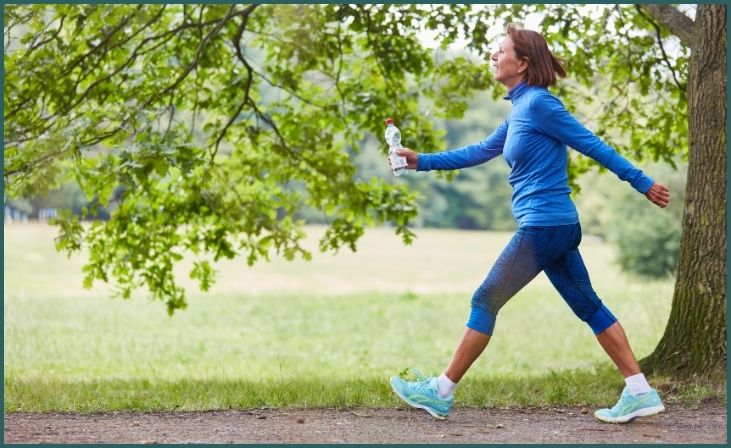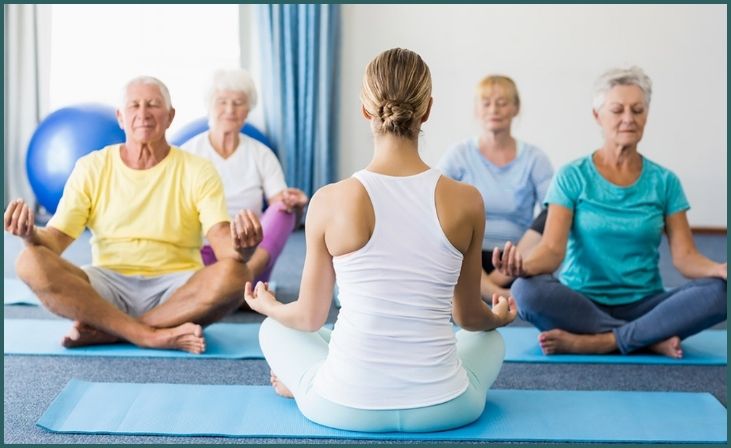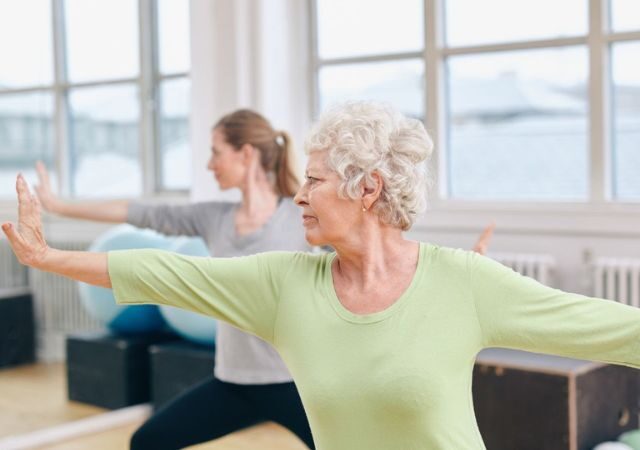Staying physically active becomes increasingly important for maintaining overall health and well-being as we age. Regular exercise can help seniors enhance their mobility, balance, and strength, reducing the risk of falls and improving quality of life. It also plays a crucial role in managing chronic conditions like arthritis, diabetes, and cardiovascular disease. Engaging in various exercises tailored to seniors can boost mental health, increase energy levels, and promote better sleep. In this guide, we will explore nine of the best exercise routines that are safe, effective, and enjoyable for older adults.
9 Best Exercise Routines For Seniors To Stay Active
1. Walking

Walking is one of the most accessible and low-impact exercises for seniors. It requires minimal equipment, just a pair of comfortable shoes, and can be done almost anywhere. Regular walking helps improve cardiovascular health, strengthen muscles, and enhance joint flexibility. Strive to engage in vigorous walking for at least 30 minutes on most days of the week. Start with shorter walks and gradually increase duration as stamina improves. Walking with a friend or in a group can also provide social interaction, adding an extra layer of motivation and enjoyment to your routine.
2. Chair Exercises
Aged individuals with difficulty with balance or mobility may benefit from chair exercises. To ensure safety and comfort, these exercises can be executed while seated. The options include arm circles, seated marches, and seated leg movements. These movements help improve strength, flexibility, and circulation without putting undue stress on the joints. Incorporating a few sets of chair exercises into your daily routine can help maintain and even improve functional abilities, making everyday tasks easier and more manageable.
Read Also:- 9 Tips For Improving Home Safety For Elderly Individuals
3. Water Aerobics
Water aerobics offers a unique blend of resistance training and cardiovascular benefits while minimizing the impact on the joints. Performing exercises in water reduces strain on the body and helps prevent injuries. Classes are often available at local community centers or pools, including water walking, swimming, and aqua jogging. Water aerobics can help improve cardiovascular fitness, muscle strength, and endurance, all while providing a refreshing and enjoyable workout experience.
4. Strength Training
Consistent strength training is essential for preserving bone density and muscle mass as we age. Seniors can use light weights or resistance bands to engage in exercises such as bicep curls, squats, and shoulder presses. Strength training helps build muscle, supports metabolic health, and improves overall functional capacity. Executing these exercises with the appropriate form and technique is crucial to prevent injury. Starting with lower weights and gradually increasing as strength improves is a good approach to ensure a safe and effective strength training routine.
5. Tai Chi

Slow, fluid movements and profound breathing techniques are the hallmarks of Tai Chi, a delicate martial art. It is especially advantageous for enhancing flexibility, coordination, and balance. The practice of Tai Chi can also reduce stress and enhance mental focus. Regular participation in Tai Chi classes can improve stability and reduce fall risk, making it an excellent option for seniors looking to boost their overall health and well-being. Many community centers provide Tai Chi classes specifically tailored to seniors.
6. Stretching
Maintaining flexibility and range of motion necessitates engaging in stretching exercises. Simple stretches, such as hamstring, shoulder, and calf stretches, can be performed daily to keep muscles supple and joints flexible. Stretching can also help reduce muscle tension and improve posture. Incorporating a stretching routine into your daily activities, ideally, after a light warm-up, can enhance overall mobility and help prevent injuries related to tight or inflexible muscles.
7. Balance Exercises
Proper balance exercises are essential for enhancing stability and preventing accidents. Simple exercises such as standing on one leg, heel-to-toe walking, and practicing gentle yoga poses can significantly enhance balance and coordination. Incorporating balance exercises into your routine helps strengthen the muscles used for stabilization and improves proprioception (awareness of body position). Regular practice can make a significant difference in maintaining independence and reducing the risk of falls.
8. Cycling
Cycling, whether on a stationary bike or a regular bicycle, provides an excellent cardiovascular workout with low impact on the joints. It helps strengthen the lower body, improve endurance, and enhance joint mobility. For seniors who enjoy being outdoors, cycling can also offer a pleasant way to explore the neighborhood or nearby trails. Starting with shorter rides and gradually increasing duration and intensity can help build endurance while ensuring safety.
Read Also:- 9 Best In-home Care Practices For Elderly Health Management
9. Yoga

Yoga combines gentle stretching, breathing exercises, and balance work to promote overall wellness. It is particularly effective for improving flexibility, reducing stress, and enhancing mental clarity. Many yoga poses can be adapted to accommodate different levels of mobility and flexibility. Participating in a beginner’s yoga class or following along with a video tailored for seniors can provide a safe and beneficial way to incorporate yoga into your fitness routine. The mindfulness aspect of yoga also contributes to better mental health and relaxation.
Conclusion: Embracing a Routine for Better Health
Incorporating these nine exercise routines into your daily or weekly schedule can profoundly impact your health and well-being as you age. From walking and chair exercises to Tai Chi and yoga, numerous options suit different preferences and fitness levels. Identifying activities that you find enjoyable and can engage in consistently is crucial. Please ensure that you consult with your healthcare provider before commencing any new exercise regimen, particularly if you have pre-existing health conditions. By staying active, you can enhance your physical health, boost your mood, and enjoy a more vibrant and fulfilling life.
FAQs
How often should seniors exercise to see benefits?
Seniors should aim for at least 150 minutes of moderate-intensity aerobic activity or 75 minutes of vigorous activity per week, combined with muscle-strengthening exercises on two or more days a week. It’s important to spread this activity throughout the week and adjust based on individual fitness levels and health conditions.
Are there any exercises seniors should avoid?
Seniors should avoid high-impact exercises such as running or jumping that may strain the joints. They should also cautiously approach high-risk activities that could lead to falls or injuries. Always consult with a healthcare provider to determine which exercises are safe and appropriate based on individual health conditions.


